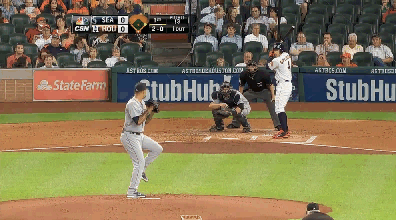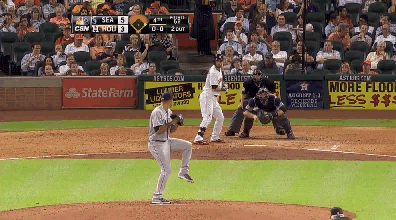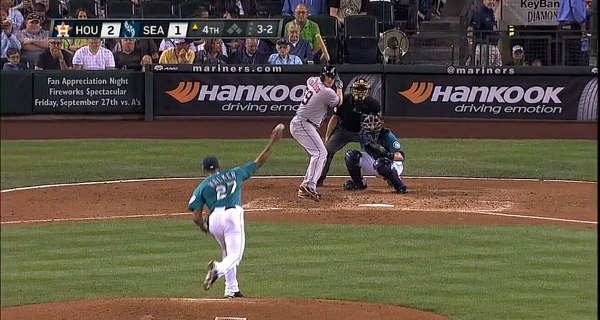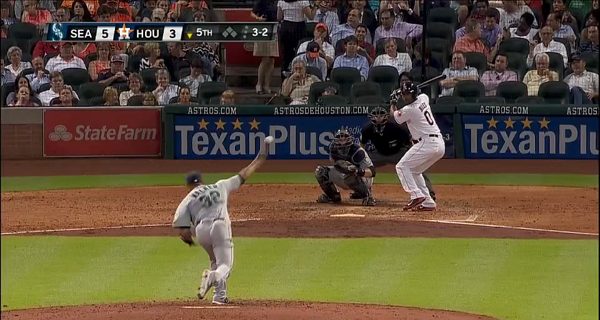What Did We See in Taijuan Walker’s Return?
Taijuan Walker is back. It’s an unusual thing to say of a guy who was barely here in the first place, but Walker finally made his big-league 2014 debut Monday night, turning in six decent frames against the Astros. The hope is he’ll stabilize a back of the rotation left in the unstable hands of Brandon Maurer and Erasmo Ramirez. More than anything, the Seattle Mariners are just happy to have Walker seemingly past his shoulder issue. If all goes well, Walker will be starting the rest of the way, and though he’s short on major-league experience, it’s interesting to note some adjustments he flashed. Walker started for the Mariners three times in 2013; his 2014 start doesn’t fit the same patterns.
Much more will be learned, of course, over the following weeks. One start against one opponent can’t be easily compared to other starts against other opponents, and so Walker will take some time to even out. But Monday, Walker showed some differences in his pitch mix. He showed a difference in his setup. And he showed a difference in his delivery. What looks like it’s changed, for one of baseball’s very best young pitching prospects? Let’s get into a little bit of detail.
Walker would be the first to say he didn’t really have his fastball early on. He pitches off his fastball, like everybody, and though there weren’t any issues with his velocity, it was more about location. Here is evidence Taijuan Walker didn’t have awesome fastball location.
So, in order to survive, Walker needed to find something else to present as an alternative. As he climbed the ladder, he drew praise for a developing cutter. In the minors, Walker’s cutter was said to be a plus pitch, and he featured a lot of it during his brief 2013 cup of coffee. But it wasn’t so, Monday night. As a matter of fact, let Walker tell you himself:
“I’m not swearing at myself, but I’m talking to myself: ‘C’mon Taijuan. Just keep the ball down and get ahead in the count,'” he said. “[Monday] my fastball command wasn’t there, so I relied on my changeup. That got me through it.”
In his first start, Walker showcased a changeup that, in the past, has been described as future-average. Of Walker’s 94 pitches, 23% were changeups, against a three-start rate of 4.3% last September. Raw changeup counts, from Brooks Baseball:
- First start (2013): 6
- Second start (2013): 2
- Third start (2013): 2
- Fourth start (2014): 21
The changeup kind of took the place of the cutter, which a year ago Walker threw a quarter of the time. Look at these movement maps, from Texas Leaguers, and ignore the faulty pitch-type classifications:
Maybe Walker wasn’t feeling the cutter because he wasn’t feeling the fastball. But it took a lot of confidence to move that heavily in the direction of the changeup. Four times, he threw it as a first pitch. Nine times, he threw it in even counts. Five times, he threw it with the batter ahead. He also used it with two strikes, and by and large, Walker did a fairly good job of keeping the changeup down, even if there were a few mistakes:
Here’s an example of a good changeup:
Here’s another example of a good changeup:
Here’s an example of a bad changeup:
Is Walker making a permanent adjustment to his repertoire? On the one hand, from a couple weeks ago:
“In my bullpen tonight, I was working on fastball command just to make sure I had it and could get ahead with that and throw my off-speed and get swings and misses with my curveball and changeup.”
On the other hand, from May:
Walker said he threw mostly fastball and cutters and that his curveball felt “all right,” though one pitch gave him trouble.
“I didn’t throw as many changeups as I’d like to, but it wasn’t really feeling too good in the bullpen,” he said.
The cutter should still be there, as we have Walker acknowledging it post-injury. But it seems like he’s developed a greater trust in his change, which would give him another weapon, if effective. There’s not a great velocity separation between the changeup and the fastball, but if the changeup stays down and if the fastball lives in the upper half, there’ll be a greater perceived separation. This is going to be interesting to follow — it’s too soon to say whether this is good or bad, but Walker might be partially replacing one weapon with another.
Moving on, Walker has also made some physical changes. Among them is he’s shifted very subtly on the rubber. Where he used to set up in the middle, now he’s moved to the extreme first-base side. This isn’t the kind of thing a pitcher does by coincidence. Pitchers are aware of where they’re standing, and Walker’s trying to change his angles. Below: 2013 and 2014:
It’s a difference of only some inches, and it might not ultimately change anything about his performance, but Walker might think this allows him to better attack the corners he wants to barrage against lefties and righties. Pitchers are frequently shifting around, and Walker’s done this for a reason.
At last, there’s the matter of Walker’s actual delivery. After the shoulder scare, Walker and the Mariners agreed on some mechanical tweaks, intended to relieve some of the stress. As part of the change, Walker’s trying to get more out of his lower body, and here’s a little bit of info:
Walker has made a mechanical adjustment where uses his legs more and finishes through pitches, with the hope it takes stress off his shoulder. He’s thrown two simulated games on his latest rehab stint, but the adjustment is still a work in progress.
“It’s still new, I’m still trying to get used to it. I’m not used to finishing violently, I guess, getting out there,” he said.
This can be hard to notice, but here are a couple screenshots taken of Walker releasing high fastballs in 2013 and in 2014:
Look at Walker’s head, shoulders, and elbow. Previously, Walker was a little more upright, but Monday he was throwing more forward, seemingly getting better extension. The pitcher below certainly looks like a pitcher getting a better drive toward home plate, and Walker now might get on top of his pitches a little more. And if it’s true that Walker is releasing the ball a little more forward, that’ll be good news for his perceived velocity, which he was by no means lacking before the injury. The main idea here is to try to increase Walker’s odds of maintaining a healthy shoulder, but he could also end up with sharper movement and a greater ability to disrupt timing. As far as the first point’s concerned, Walker’s curveball did show a little more run and a little less drop, with a little more oomph.
What you’re looking at is an over-analysis of one start. And it’s one start by a pitcher who isn’t even fully comfortable yet with his adjusted mechanics. Of course this is going to take time before we can analyze results. But Taijuan Walker was already a guy to watch, when he was first coming up. Now he’s worked his way through a shoulder scare, and he’s modified the way he throws, with hints that he’s also modifying which pitches he throws in which proportions. The goal is always to get better and to stay healthy. We don’t know if Walker’s going to accomplish one, or both. But at least now we get to start finding out. And at least now we get to watch Taijuan Walker instead of Erasmo Ramirez. The thing about injured young pitchers is they tend to come back.
Jeff made Lookout Landing a thing, but he does not still write there about the Mariners. He does write here, sometimes about the Mariners, but usually not.










I posted this in the Daily Notes a week ago and didn’t get much feedback, so, just to be clear, how does one pronounce “Taijuan”?
Like the Asian country.
Like, being a M’s fan makes you want to Taijuan On.
Excellent, I was right. Thanks!
Now I hope they sign Chien-Ming Wang and he gets confused by the locker room conversations.
Lol. That’s why I can’t talk to my dad about Julio Teheran.
“Hong Kong”